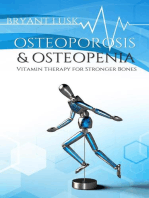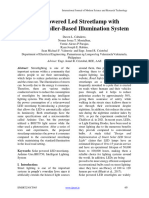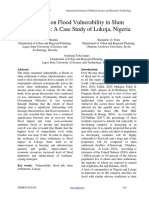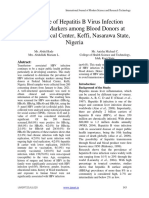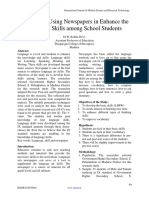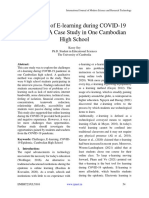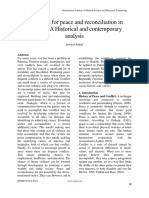Prevalence of Bovine Ixodid Ticks With Amitraz and Diazinon in Vitro Efficacy Evaluation in Bedano and Gola Oda Districts of Eastern Hararge, Ethiopia
Prevalence of Bovine Ixodid Ticks With Amitraz and Diazinon in Vitro Efficacy Evaluation in Bedano and Gola Oda Districts of Eastern Hararge, Ethiopia
Uploaded by
IJMSRTCopyright:
Available Formats
Prevalence of Bovine Ixodid Ticks With Amitraz and Diazinon in Vitro Efficacy Evaluation in Bedano and Gola Oda Districts of Eastern Hararge, Ethiopia
Prevalence of Bovine Ixodid Ticks With Amitraz and Diazinon in Vitro Efficacy Evaluation in Bedano and Gola Oda Districts of Eastern Hararge, Ethiopia
Uploaded by
IJMSRTOriginal Description:
Copyright
Available Formats
Share this document
Did you find this document useful?
Is this content inappropriate?
Copyright:
Available Formats
Prevalence of Bovine Ixodid Ticks With Amitraz and Diazinon in Vitro Efficacy Evaluation in Bedano and Gola Oda Districts of Eastern Hararge, Ethiopia
Prevalence of Bovine Ixodid Ticks With Amitraz and Diazinon in Vitro Efficacy Evaluation in Bedano and Gola Oda Districts of Eastern Hararge, Ethiopia
Uploaded by
IJMSRTCopyright:
Available Formats
Volume 1, Issue 7, July 2023 International Journal of Modern Science and Research Technology
Prevalence of Bovine Ixodid Ticks with Amitraz
and Diazinon in Vitro Efficacy Evaluation in
Bedano and Gola Oda Districts of Eastern
Hararge, Ethiopia
Jemal Ahmed Mume
College of Veterinary Medicine, Haramaya University, Ethiopia
Abstract:
Ethiopia has the biggest number of domestic with the occurrence of tick infestation (p
animals on the continent and the highest <0.05). A total of 626 adult ticks were
livestock population in the world, ranking collected from animal body parts and
first in Africa and tenth overall in the world. identified to genera and species level. Four
The evolution of tick resistance to acaricides genera and five tick species were identified.
has been a major determinant of the need for The proportions for the tick infestation for
new products, the efficacy of chemical Amblyomma (8.5%), Rhipicephalus
acaricides can be investigated from trials at (Boophilus) decolaratus (6.07%), Hyalomma
in vitro or in vivo to choose the appropriate (19.5%), and Rhipicephalus (18.21%) were
acaricides. A cross-sectional study was reported in the study area. Those identified
conducted from June 2022 to October 2022 species were: 10.22%, 5.59%, 0.15%,
Prevalence of Bovine Ixodid Ticks With 19.5%, and 8.5% of cattle found in Bedano
Amitraz and Diazinon In Vitro Efficacy and Gola Oda to be infested by
Evaluation In Bedano and Gola Oda Rhipicephalus sanguineous, Rhipicephalus
Districts of Eastern Hararge, Ethiopia. To evertsi evertsi, Rhipicephalus praetextatus,
find out the major factors associated with the Hyalomma and Amblyomma variegatum.
occurrence of ticks and to identify common Rhipicephalus pulchellus (30.4%) was found
tick genera and species. A total of 222 cattle to be the most abundant genera, while
were selected randomly and examined, of Hyalomma Analoticm (0.8%) accounted for
which 222 (100%) were found to be infested the least prevalent tick species. On in vitro
by one or more tick genera and species. acaricidal efficacy test, amitraz and diazinon
Out of the examined cattle, 76.6%, 27.93% resulted in 90% and 88.3% reductions in
and 8.1% were found infested by mean tick count compared to the control.
Rhipicephalus spp., Hyalomma spp. and The acaricidal efficacy of amitraz was
Amblyomma spp., respectively. The study superior over diazinon as it showed the
looked at the relationship between highest percentage. Therefore, effective
infestation with Rhipicephalus spp., control measures should be undertaken to
Hyalomma spp. and Amblyomma spp. and bring the needed health and productive
potential risk factors including woreda, sex, animals in Gola oda and Bedano woredas.
age, body condition scores, and herd size all Key words: Amitraz, Acaricidal Efficacy
of them showed a significant association Diazinon, East Hararghe, Ixodid Ticks.
IJMSRT23JUL033 www.ijmsrt.in 160
Volume 1, Issue 7, July 2023 International Journal of Modern Science and Research Technology
1. Introduction: worldwide and in /warmer areas (10). Ticks
1.1. Background are obligate hematophagous ecto-parasites
Ticks are obligate hematophagous and carriers of both animal and human
ectoparasites and disease vectors in both diseases (11). According to (12), ticks
animals and humans. They are responsible biological are members of the order Acarina
for animal hide losses and inject chemicals and phylum Arthropod. According to there
that diminish productivity or cause death (1). are roughly seven genera of ticks that are
Tick-borne illnesses harm 80% of the thought to be the most significant to the
world's cattle population, with an estimated health of domestic animals in Africa. In
yearly global loss of US$ 13.9 billion to several regions of the country, the genera
US$ 18.7 billion due to ticks (2). Ticks are Amblyomma and Rhipicephalus are
also a target of the emerging one health dominant; Hyalomma and the subgenus
concept since they transmit numerous Rhipicephalus (Boophilus) also play
diseases that cause disease in humans and important roles (12). Over 47 species of
animals (3). ticks are reported infesting cattle in Ethiopia,
Ethiopia has the biggest number of domestic and the majority of them are significant as
animals on the continent and the highest disease carriers and vectors with negative
livestock population in the world, ranking effects on the growth of skin and hide.
first in Africa and tenth overall (4). Due to Furthermore, they reduce body weight gains
their geographic location and diversity, the and milk yield, in addition to creating sites
major agro-ecological zones of the country for secondary invasion by pathogenic
may support a large number and variety of organisms (13)
livestock (5). One of the nations in Africa Members of the family Ixodidae undergo
with the highest cattle populations is either one-host, two-host or three-host life
Ethiopia. Ethiopia has the largest livestock cycles. During the one-host life cycle, ticks
population in Africa with an estimated 60.4 remain on the same host for the larval,
million cattle, 31.3 million sheep, 32.7 nymphal and adult stages, only leaving the
million goats, 2.0 million horses, 0.5 million host before laying eggs (14). More
mules, 8.9 million donkeys, 1.4 million significantly, ticks transmit diseases from
camels, and 56.1 million chickens, infected cattle to healthy ones. Ticks
according to the Central Statistics Authority transmit a greater variety of pathogenic
(6) micro-organisms than any other arthropod
Livestock farming remains essential for vector group, and are among the most
resource-constrained smallholder farmers in important vectors of diseases affecting
Ethiopia as a source of milk, meat, skin, animals. The distribution and abundance of
manure, and traction force (7). Ticks are the tick species infesting domestic ruminants in
most economically significant ectoparasites Ethiopia vary greatly from one area to
for livestock in the tropics, particularly in another area, Amblyomma gemma, is also
sub-Saharan Africa (8). After trypanosomes recorded in eastern and southern Ethiopia
and end parasitism, ticks and diseases (15).
transmitted by ticks are Ethiopia's third- Risk factors related to Ixodid ticks’
largest parasitic threat. Ticks cause infestation were substantially correlated with
significant losses in the livestock industry age, sex, and breed, but not with body
(9). condition score or time of year in cattle (13).
Ticks are tiny wingless, ectoparasitic According to Hara maya woreda has a high
arachnid arthropods that are common overall prevalence of the descending order
IJMSRT23JUL033 www.ijmsrt.in 161
Volume 1, Issue 7, July 2023 International Journal of Modern Science and Research Technology
of abundance, the recognized tick species socio-economic development (19). On the
were B. decolaratus extremely high, R. other hand, using the same acaricide
evertsi subsp. evertsi high, A. variegatum repeatedly over an extended period of time
medium, A. coherence lower, and A. leads to acaricide resistance (29). A major
lepidum rare (13). Using a economic danger to livestock and related
stereomicroscope, the collected ticks were businesses is the decline in the market value
identified and divided into distinct genera of dairy, meat, skins, and hides used to make
according to size, mouthpart color, body leather and other livestock products (20).
color, leg color, and the presence or absence Cheap chemicals like diazinon and amitraz
of an eye. The prevention and transmission are frequently used in Ethiopia to control
of tick-borne diseases remain a difficulty for ectoparasites like ticks. Despite their use, the
the global cattle industry due to ticks' majority of the country, including the study
economic and veterinary importance, and it areas, still has a high incidence of cattle
is a top concern for many nations in tropical ticks (21). Due to adaption by tick species,
and subtropical areas (16). ticks are developed acaricide resistance over
Ticks are the most significant cattle time. The creation and application of
ectoparasites in terms of economic impact, acaricides helped to stop the spread of
causing significant production losses due to diseases carried by ticks (1).
illnesses, decreased productivity, decreased However, an insufficient study was on tick
fertility, and frequently mortality. species composition, their infestation and
Nowadays, an estimated 80% of the the residual efficacy of acaricide. Hence, the
country's rural population relies on cattle for research on bovine tick prevalence and
their livelihood (17). acaricides efficacy may benefit farmers,
Acaricides are chemicals used to control policymakers, veterinarians, and extension
ticks, but the excessive use of these staff in designing interventions based on
chemicals accelerates ticks’ resistance (6) evidence. It is essential to improve
The evolution of tick resistance to acaricides interventions against ticks. Therefore, the
has been a major determinant of the need for current study was conducted with the
new products, the efficacy of chemical purpose of estimating Prevalence of Bovine
acaricides can be investigated from trials at Ixodid Ticks with Amitraz and Diazinon in
in vitro or in vivo to choose the appropriate Vitro Efficacy Evaluation in Bedano and
acaricides (18). Diazinon and amitraz are Gola Oda Districts of Eastern Hararge,
cheap chemicals widely used for tick control Ethiopia
and other ecto-parasites in Ethiopia (15).
The development and application of 1.3. Objectives
acaricides contributed to the prevention of 1.3.1. General Objective
tick-borne diseases. However, ticks evolve Prevalence of Bovine Ixodid Ticks with
acaricides resistance through years due to Amitraz and Diazinon In Vitro Efficacy
adaptation by tick species (16). Evaluation In Bedano and Gola Oda
Districts of Eastern Hararge, Ethiopia
1.2. Statement of the problem:
Ticks are one of the most significant 1.3.2. Specific Objectives
ectoparasites of animals and a key means of I. To estimate the prevalence of ticks’
disease transmission on a global scale. They infestation
have a significant negative impact on II.To identify common species of bovine
Ethiopia's leather industry, economy, and ticks
IJMSRT23JUL033 www.ijmsrt.in 162
Volume 1, Issue 7, July 2023 International Journal of Modern Science and Research Technology
III.To identify associated risk factor in the Malka Belo. Figure 1 presents the map of
study area (GODAB UN published data, 2014, and
IV.To evaluate efficacy of diazinon and BDAB unpublished data, 2014). Gola Oda
amitraz against bovine Ixodid ticks and Bedano woreda are characterized by
mid-subtropical temperature ranges and
2. Materials and Methods: tropical temperatures of 20°C–35°C and 15–
2.1. Study Area Description: 28°C, respectively. The annual average
The study is conducted in Gola Oda and rainfall is 1700 mm, and the soil is mostly
Bedano Woreda of the Eastern Hararghe clay, with some black soil in some areas.
Zone, Ethiopia. The area lies between 09°08' Gola Oda and Bedano woreda have
N and 09°13' E latitude and 42°14' N and topographic areas of 4219.645674 km2 and
42°23' E longitude, with an elevation span of 980.344039 km2, respectively, and is
1182 and 1936 meters above sea level at lowland and highland areas. The highland
Gola Oda and Bedano, respectively. Gola areas are found centrally, and the lowlands
Oda and Bedano are found at 846 km and dominate the periphery of the area. The
802 km east of Addis Ababa, respectively. livestock population of Gola Oda woreda
The boundary of Gola Oda and Bedano comprises about 931475 cattle, 64,506
woreda: north Goro Muxii, southern Kumbi, sheep, 213,4047 goats, 17,439 donkeys, 50
eastern Meyo and Garawa, and western mules, and 175,382 chickens. Total
Population in Gola Oda: 58,754 Male
29,010 and Female 29,744
Figure 1: Maps of study area
Source: Prepared by the author using Arc GIS software from GIS
IJMSRT23JUL033 www.ijmsrt.in 163
Volume 1, Issue 7, July 2023 International Journal of Modern Science and Research Technology
2.2. Study Population: 2.4. Sample Size Determination
Cattle raised under extensive and semi- 2.4.1. Sample Size Determination for Tick
extensive production systems in Gola Oda Infestation and Study:
and Bedano woredas, which were The sample size for the study of tick
representative of local (native) cattle, make infestation and identification was
up the study population. determined using the formula given by
Thrusfield (2018) for simple random
2.3. Study Design and Method of sampling.
Sampling: n = 1.962 Pexp (1 - Pexp)
A cross-sectional study and clinical trial d2
were conducted from July 2022 to October Were
2022 to determine the Prevalence of Bovine n = sample size;
Ixodid Ticks with Amitraz and Diazinon in Pexp= Expected prevalence;
Vitro Efficacy Evaluation in Bedano and d = Desired level of precision (5%)
Gola Oda Districts of Eastern Hararge,
Ethiopia. The desired sample for the study was
Two woredas in the east Hararghe Zone determined by taking an expected
were purposefully selected based on the prevalence of 82.8% tick infestation
previous history of the occurrence of tick- (22),setting a 95% confidence level and 5%
borne disease. Then, using information desired absolute precision. It resulted a
gathered from the Agricultural Offices of the sample size of 222 and therefore; each
woreda, a list of Kebles (the lowest Kebles take 37 cattle were examined.
administrative unit) within the woreda were
created. Tortora Kela, Illii Darartu, Jiru 2.4.2. Sample Size Determination for
Ballina, Tirtira 03, Jaben, and Bareda Lenca Acaricide Efficacy Test:
are then chosen in the Bedano and Gola Oda The sample size of ticks required for the in
categories, respectively. Three sample vitro acaricidal efficacy test was 240
Kebles from each woreda were randomly calculated using the formula described by
selected using a lottery system. Villages in (18), assuming a 95% confidence level of
each Kebles were selected in collaboration 0.05, power = 0.90 (table value = 10.51),
with the respective district’s animal health and equal sample size in treatment and
personnel by purposive sampling based on control groups. According to (3), the overall
farmers’ cooperation, logistics, and share of 84.9 expected efficacy of the tested acaricide
communal grazing land. Ticks were was considered 100%.
collected, after casting the animals, by using 〔(𝑹 + 𝟏) − 𝑷𝟐(𝑹𝟐 + 𝟏)〕
thumb forceps and manually, without 𝒏 = 𝒑𝒐𝒘𝒆𝒓
𝑷𝟐(𝟏 − 𝑹)𝟐
causing damage to the tick's head or other Were,
body parts. n = the sample size in each of the group
The age of animals is identified and P1 = event rate in the treatment group
classified as 1 year, between 1–3 years, and P2 = event rate in the control group
>3 years in accordance with the R = risk ratio (P1/P2)
classification method used. Similarly, the 90% reduction will be assumed: cut-off
body condition scores (good, medium, and point (23).
poor) are applied in accordance with the
standards.
IJMSRT23JUL033 www.ijmsrt.in 164
Volume 1, Issue 7, July 2023 International Journal of Modern Science and Research Technology
2.5. Data Collection: Parasitology Laboratory for the in vitro
Tick collection at the site occurs on the acaricidal efficacy assessment using a
preferred site of the animal body. modified adult immersion test (AIT). The
According, ticks that were found on the recommended concentration of acaricides
difference side of animals at various (1:1000 for Diazinon, 1:625 for Amitraz)
preferred locations (body zones), including were used for the test. For each acaricide
the ear, neck, dewlap, abdomen, anus, hip, efficacy test, three replicates containing 10
udder, scrotum, and base of the tail. The data ticks were immersed in 20 ml of water, or 20
collection formats were used to register ml of each acaricide was placed in a 100 ml
animal data collected during tick collection. plastic container. All the ticks from the
Tick samples placed into universal bottles, treatment and control groups were
which were labeled. Proper labeling was transferred to a Petri dish. Distilled water
done on universal bottles with permanent was used as a control. The number of ticks,
markers. Collection date, address, animal live or dead were counted after 24 hours of
species, sex, age, animal code, and location exposure. The experiment was repeated
were included in the label according to the three times for precision.
collection point. The collected ticks were
preserved in a 10% formalin preservative, 2.8. Data Processing and Analysis:
placed in a grooming box, and transported to The collected data was entered into
Haramaya University's College of Microsoft Excel Spreadsheet (Microsoft
Veterinary Medicine and Parasitology version 2013) and then cleaned, coded and
Laboratory for tick identification. However, stored till the analysis. Then the data was
ticks, which were required for acaricidal in transferred into STATA 16 Statistical
vitro efficacy, were placed in unpreserved Package for analysis. The prevalence of
bottles. The in vitro acaricidal efficacy ticks was determined by dividing the
evaluation was performed using a modified number of cattle infested by the total number
adult immersion assay (AIT). of cattle included in the study and
multiplying it by 100. The strength of
2.6. Tick identification: association between various risk factors and
All ticks collected from different animals the prevalence of the different genera of
and body zones were examined separately Ixodid ticks was determined using a
under the stereomicroscope and identified at Univariable logistic regression analysis and
the species level using standard. crude odds ratios with 95% confidence
intervals were obtained. The mean’s ratio of
2.7. In Vitro Acaricide Efficacy Test or ticks between the treatment and control
Susceptibility Test: groups is used to determine the efficacy of
In vitro tests were done in the laboratory to acaricide at different days after treatment
assess the susceptibility status of cattle ticks (percentage reduction). Paired sample t-tests
to amitraz and diazinon. Adult ticks were are used to compare the efficacy of amitraz
collected in the field from different herds and diazinon. All statistical analyses are
and then placed in plastic flasks pre-labeled considered significant at p < 0.05.
with the time, date, and place of collection.
The samples were collected from the 3. Result:
medially transverse of the right side of the 3.1. Prevalence of Bovine Ixodid
animal. The collected ticks were transported
Tick Infestation
to the Haramaya University Veterinary
IJMSRT23JUL033 www.ijmsrt.in 165
Volume 1, Issue 7, July 2023 International Journal of Modern Science and Research Technology
A total of 222 cattle from two different 9(7.89%), respectively while in Gola Oda
woredas were examined and all (100%) woreda were 31(26.27%) and 2(1.69%) in
were found infested with at least one tick that order.
species. Table 2 presents the prevalence of In the prevalence of tick infestations in cattle
tick infestation by the studied woredas and of different Kebles and one genus of hard
Kebles. Out of 222 cattle examined, 162 tick (Rhipicephalus genera), associations of
(73%), 49 (22.1%), and 11 (4.95%) cattle the Badeno and Gola Oda woredas were
were found infested by Rhipicephalus spp., observed. Different prevalence of tick
Hyalomma spp., and Amblyomma spp., infestations was recorded in six kebles, with
respectively. From 111 animals examined in 86.5%, 54.05%, 75.7%, 71.93%, 94.6%,
Gola Oda 82(73.9%) cattle were found to be 72.97%, and 54.1% in Ililli Darartu, Tortora
infested by Rhipicephalus spp. the most kela, Jiru Ballina, Bareda Lenca, Jaben, and
dominant tick genera identified followed by Tirtira 03, respectively. A relatively high
Bedano in which 80 (72.1%) of 111 tick infestation was recorded in Gola Oda in
examined cattle were infested. the number Bareda Lenca Keble (94.6%), and the lowest
and proportion of cattle infested Hyalomma tick infestation was in Tirtira 03 (54.1%)
spp. and Amblyomma spp. of ticks in Keble (Table 2).
Bedano woreda were 23(26.18%) and
Table 1: The prevalence of tick infestations with woreda, Keble and distribution of tick
species in study area.
Number positive (%)
Number Amblyomma Hyalomma Rhipicephalus
Woreda Keble examined spp. spp. spp.
Bedano Ililli Darartu 37 5(13.52) - 32(86.5)
Tortora kela 37 4(10.81) 13(35.14) 20(54.05)
Jiru Ballina 37 - 9(24.32) 28(75.7)
Total 111 9(8.10) 22(19.8) 80(72.1)
Gola Oda Bareda Lenca 37 - 2(5.41) 35(94.6)
Jaben 37 2(5.41) 8(21.62) 27(72.97)
Tirtira 03 37 - 17(45.94) 20(54.1)
Total 111 2(1.8) 27(24.32) 82(73.9)
Overall 222 11(4.95) 49(22.1) 162(73)
Key: spp= species, %= percentage
IJMSRT23JUL033 www.ijmsrt.in 166
Volume 1, Issue 7, July 2023 International Journal of Modern Science and Research Technology
3.2. Association Between Tick infestation was highest prevalence infested by
with Animal Related Factors Amblyomma spp. Compared with female.
3.2.1. Amblyomma species: Different age groups of animals were
The prevalence of Amblyomma spp. observed for Amblyomma spp. infestations.
infestation with hypothesized risk factors Young animals (107) were examined in
woreda, sex, age, body condition scores and greater numbers, with 6(5.6%) infested by
herd size is summarized in (Table 3). The Amblyomma spp., compared to adult
study revealed that the prevalence of animals. Regarding the body condition of
Amblyomma spp. infestation with compered the cattle, out of 222 animals examined, 87
to logistic regration, Univariable and animals were in good body condition, and
Association risk factors for analysis such as out of these 5 (5.75%) animals was positive
woreda, sex, age, body condition scores and for Amblyomma spp. Infestation. Therefore,
herd size was statistically significant in all a high prevalence of tick infestation was
factors in the study area (P<0.05) is recorded in animals in good body condition
summarized (Table 3). A total of 222 cattle compared with other one. Regarding the
from two different woredas were examined, herd size of the cattle, out of 222 animals
and overall, out of the 111 animals examined, 11 animals were in a large group,
examined, 9 (8.1%) cattle were found in and out of these, 1 (9.09%) were positive for
Bedano to be infested by each of the tick infestation. Therefore, a high prevalence
Amblyomma spp. The highest prevalence of tick infestation was recorded in the large
was recorded in Bedano compared to other group compared with another group follow
one. Regarding to sex, out of 222 cattle the table below (Table 3).
examined, 113 were male; 8 (7.07%) male
Table 2: Prevalence of tick’s species infestation and its associated risk factors in Bedano and
Gola oda district
#of Animals #of Prevalence COR
Variable Category Examined Animals (%) (95% CI) P-value
Infested
Woreda Gola Oda 111 3 2.70 1.0 (ref.)
Bedano 111 9 8.1 3.29 (0.87-12.4) 0.040
Sex Female 109 4 3.67 1.0 (ref.)
Male 113 8 7.07 2.04 (0.60-6.96) 0.027
Age group Young 107 6 5.6 1.0 (ref.)
Adults 115 6 5.22 1.04 (1.32-3.31) 0.050
Body Poor 36 2 5.6 1.0(ref.)
condition Medium 100 5 5.00 0.97 (0.18-5.24) 0.010
Good 87 5 5.75 1.05 (0.20-5.66) 0.050
Herd size Small 138 8 5.8 1.0 (ref.)
Medium 73 3 4.1 0.70 (0.18-2.73) 0.012
Large 11 1 9.09 1.71 0.19-15.08) 0.028
IJMSRT23JUL033 www.ijmsrt.in 167
Volume 1, Issue 7, July 2023 International Journal of Modern Science and Research Technology
3.2.2. Hyalomma species:
The prevalence of Hyalomma species. infested by Hyalomma spp. Different age
infestation with hypothesized risk factors groups of animals were observed for tick’s
woreda, sex, age, body condition scores and infestation. young animals (110) were
herd size is summarized in follow the table examined in greater numbers, with 28
(25.45%) infested by ticks, compared to
below (Table 4). The study revealed that the
adult animals. Regarding to the body
prevalence of Hyalomma spp. infestation with condition Different group of the cattle, out
compered to logistic regration, Univar able and of 222 animals examined, 86 were in a good
Association risk factors for analysis such as body condition state, and out of these 28
woreda, sex, age, body condition scores and (32.56%) animals was positive for
herd size was statistically significant in all Hyalomma spp. infestation; therefore, a high
factors was showed in the study area (P<0.05) is prevalence of Hyalomma spp. infestation
concluded follow the below (Table 4). A total of was recorded in animals in good body
condition compared with other. Regarding
222 cattle from two different woreda were
the herd size of the cattle, out of 222 animals
examined, and overall, out of the 111 animals
examined, 11 were in the large group, and
examined, 31 (27.93%) cattle were found in out of these 3 (27.27%) animals were
Gola oda to be infested by each of the positive for Hyalomma spp. infestation;
Hyalomma spp. Highest prevalence was therefore, a high prevalence of tick
recorded in Gola oda compared with other. infestation was recorded in the large group
According to sex, out of 222 cattle examined, were compared with other; follow the table
114 were male; 32 (28.07%) male was highest below (Table 4)
prevalence
Table 3: Prevalence of Hyalomma spp. infestation and its associated risk factors in Bedano and
Gola Oda woreda
#of #of
Animals Animals Prevalence Odds Ratio
Variable Category Examined Infested (%) 95% CI) P-value
Woreda Bedano 111 23 20.72 1.0 (ref.)
Gola oda 111 31 27.93 1.41 (0.76-2.61) 0.003
Sex Female 108 22 20.37 1.0 (ref.)
Male 114 32 28.07 1.59 (0.86-2.95) 0.040
Age Adults 112 26 23.21 1.0 (ref.)
Young 110 28 25.45 1.15 (0.63-2.12) 0.009
Body Poor 36 7 19.44 1.0(ref.)
condition Medium 100 19 19.00 1.07 (0.41-2.80) 0.006
Good 86 28 32.56 1.97 (0.78-4.99) 0.003
Herd size Small 138 35 25.36 1.0(ref.)
Medium 73 16 21.9 0.84 (0.43-1.64) 0.005
Large 11 3 27.27 1.18 (0.30-4.57) 0.006
IJMSRT23JUL033 www.ijmsrt.in 168
Volume 1, Issue 7, July 2023 International Journal of Modern Science and Research Technology
Key: #= number, %= percentage, CI= cumulative incident and p-value
3.2.3. Rhipicephalus species: female was highest prevalence infested by
The prevalence of Rhipicephalus spp. Rhipicephalus spp. Different age groups of
infestation with hypothesized risk factors animals were observed for tick’s infestation.
woreda, sex, age, body condition scores and Adult animals (112) were examined in
herd size is summarized in follow the table greater numbers, with 87 (77.7%) infested
below (Table 5).The study revealed that the by ticks, compared to young animals.
prevalence of Rhipicephalus spp. infestation Regarding the body condition of the cattle,
with compered to logistic retraction, out of 222 animals examined, 90 were in a
Univariable and Association risk factors for medium body condition state, and out of
analysis such as woreda, sex, age, body these 76 (84.44%) animals was positive for
condition scores and herd size was Rhipicephalus spp. infestation; therefore, a
statistically significant in all factors was high prevalence of Rhipicephalus spp
showed in the study area (P<0.05) is infestation was recorded in animals in
concluded follow the below (Table 5). A medium body condition compared with
total of 222 cattle from two different woreda other. Regarding the herd size of the cattle,
were examined, and overall, out of the 111 out of 222 animals examined, 135 were in
animals examined, 85 (76.6%) cattle were the small group, and out of these 103
found in Gola oda to be infested by each of (76.3%) animals were positive for
the Rhipicephalus spp. Highest prevalence Rhipicephalus spp. infestation; therefore, a
was recorded in Gola oda compared with high prevalence of tick infestation was
other. Out of 222 cattle examined, 109 were recorded in the small group were compared
female and 113 were male; 89 (81.65%) with other; follow the table below (Table 5).
Table 4: Prevalence of tick’s species infestation and its associated risk factors in Bedano and
Gola Oda district.
Variable Category #of Animals #of Animals Prevalence Odds Ratio P-
Examined Infested (%) (95% CI) value
Woreda Bedano 111 82 73.9 1.0 (ref.)
Gola Oda 111 85 76.6 1.01 (0.57-1.78) 0.006
Sex Male 113 78 69.02 1.0 (ref.)
Female 109 89 81.65 1.71 (0.96-3.06) 0.030
Age Young 110 80 72.73 1.0 (ref.)
Adults 112 87 77.7 1.19 (0.67-2.12) 0.007
Body Good 93 61 65.59 1.0 (ref.)
condition Medium 90 76 84.44 1.66 (0.89-3.11) 0.003
Poor 39 30 76.92 1.75 (0.74-4.13) 0.002
Herd size Large 11 7 63.64 1.0 (ref.)
Medium 76 57 75.00 1.71 (0.45-6.51) 0.008
Small 135 103 76.3 1.40 (0.39-5.04) 0.005
Ref.: reference; CI: Confidence interval
IJMSRT23JUL033 www.ijmsrt.in 169
Volume 1, Issue 7, July 2023 International Journal of Modern Science and Research Technology
3.3 Abundance of Bovine Ixodid Rhipicephalus pulchellus (30.4%) accounted
tick species in the study area: for the highest proportion, while Hyalomma
Out of the total of 626 ticks collected, analoticum (0.8%) was the least abundant
Rhipicephalus pulchellus (30.4%) was found (table 6). The collected ticks were identified
to be the most abundant genera, while as male and female, with the proportion of
Hyalomma analoticum (0.8%) accounted for female ticks being higher than that of male
the least proportion (table 6). Similarly, of (table 6).
the total ticks collected and identified,
Table5: Abundance and sex ratio of Bovine Ixodid tick species in the study area
Sex M: F Relative
Tick Species Identified Male Female Total Ratio Abundance
(%)
Amblyomma variegatum 41 31 72 1.3:1 11.5
Hyalomma impeltum 5 3 8 1.7:1 1.3
Hyalomma analoticm 4 1 5 4:1 0.8
Hyalomma Truncatum 75 76 151 1:1.01 24.1
Rhipicephalus pulchellus 99 91 190 1.1:1 30.4
Rhipicephalus sanguine 25 39 64 1:1.6 10.2
Rhipicephalus (Boophilus) 17 21 38 1:1.2 6.1
decolaratus
Rhipicephalus evertsi evertsi 30 31 61 1:1.03 9.7
Rhipicephalus praetextatus 15 22 37 1:1.5 5.9
Total 311 315 626 1:1.01 100%
3.4. Tick Distribution:
Different tick species showed preferences except for the different neck. Rhipicephalus
for attachment sites on the animal’s body. (Boophilus) decolaratus was collected from
The most preferred body sites for the dewlap, perineum, and neck.
Amblyomma variegatum species were Rhipicephalus evertsi evertsi was collected
ventral body parts: scrotum/udder, axial, from the scrotum/udder, neck, under tail,
groin/belly, under the tail, and perineum. dewlap, and ear. Similarly, Rh. pulchellus
Hyalomma analoticum was collected from was collected from smooth body parts of the
the perineum and neck. Hyalomma ear, perineum, and under tail, whereas
impeltum was collected from the ear and Rhipicephalus praetextatus was collected
neck. Hyalomma trancatum and Rh. from smooth skin under the tail, the ear, and
sanguine were similar sites collected from the neck (Table 7).
the groin or belly, under the tail, perineum,
and ear,
IJMSRT23JUL033 www.ijmsrt.in 170
Volume 1, Issue 7, July 2023 International Journal of Modern Science and Research Technology
Table 6: Distribution of tick species in different body or predilection sites of cattle.
Attachments site and proportion of Ixodid ticks (%)
Amblyo Hyalo Hyalo Hyalo Rh. Rh. Rh.(Boop Rh. Rh.
mma mma mma mma Pulche Sang hilus) e. praetex
Predile Variegat Analot impelt truncat llus uine Decolarat evert tatus Total
ction um icm um um (%) (%) us (%) si (%)
site (%) (%) (%) (%) (%)
Axial 17(100) - - - - - - - - 17(10
0)
Belly/g 16(18.3 - - 36(41. - 35(40 - - - 87(10
roin 9) 38) .2) 0)
Dewlap - - - 0 - - 16(88.9) 2(11) - 18(10
0)
Ear - - 2(2) 24(24) 69(69) 1(1) 0 1(1) 3(3.00) 100(1
00)
Neck - 3(4.76) 3(4.76) - - 27 11(17.5) 18(2 1(1.59) 63(10
(42.8 9) 0)
6)
Perineu 1(0.89) 2(1.79) - 52(46) 45(40. 1(0.8 11(9.82) - - 112(1
m 2) 9) 00)
Scrotu 19(57.5 - - - - - - 14(4 - 33(10
m 8) 2.0) )
Udder
Under 4(2.68) - 3(2.01) 39(26. 76(51) - - 11(7 16(10.7 149(1
tail 2) 4.0) ) 00)
Smooth - - - - 0 - - - 17(100) 17(10
skin 0)
Key: Rh= Rhipicephalus
3.5. In vitro Acaricide Efficacy Test: on H. truncatum 92.8%, compared with
In vitro, Amitraz and Diazinon were the other spp. As well as treated with Diazinon
tested agents; on the genera of reduction, was highest prevalence on Rh.spp 92.3%
prevalence was recorded at 90% and 88.3%, compared with other species? Hence, in an
respectively. According to species In vitro, in vitro trial, amitrzaz was more superior to
Amitraz and Diazinon were tested on diazinon.
species such as A. variegatum, B.
decoloratus, H. truncatum, and Rh. species.
Amitraz reduction prevalence was highest
IJMSRT23JUL033 www.ijmsrt.in 171
Volume 1, Issue 7, July 2023 International Journal of Modern Science and Research Technology
Table7: The result of In vitro acaricide drug efficacy test
Treatment Trial I Treatment Trial II
# of ticks Acaricidal # of ticks Acaricidal
Tick species Condition Amitraz Control efficacy Diazinon Control Efficacy
(%) (%)
All Live 6 55 7 55
Dead 54 5 90 53 5 88.3
Amblyomma Live 3 22 2 22
variegatum Dead 20 1 87 20 1 90.9
Boophilus Live 1 12 1 12
(Rh.) Dead 12 1 92.3 12 1 92.3
decoloratus
Hyalomma Live 1 11 2 12
truncatum Dead 13 3 92.8 11 3 84.6
Rhipicephalus Live 1 9 2 9
spp. Dead 9 - 90 10 - 83.3
#
Number
of the study areas, since tick activity was
4. Discussion: influenced by rainfall, altitude and
Different tick species are widely distributed
in Ethiopia, and a number of researchers
have reported the distribution and abundance at mospheric relative humidity according to
of tick species in different parts of the (24).
country (18). The current study reveals that, Rhipicephalus species were found to be the
total of 222 cattle from two local areas of the more prevalent tick genera, with a
study areas were examined and overall, of prevalence of 72.1% and 73.9% of total ticks
222 (100%) cattle were found to be infested collected in Bedano and Gola Oda,
by different genera and species of ticks. This respectively, in the present study area.
finding is closely with the report of (21), Similarly,(11) reported a 70.8%(24)
with a prevalence of 98.2% (377/384) in prevalence of A. Coherence in Haramaya
Dillo, Borena , with that of (17), with and an 83.1% prevalence of A. coherence in
prevalence of 93.8% in Babile and with that Jimma. Hyalomma species was the second
of (15) with prevalence of 98.4% in Yabelo. abundant tick with a prevalence of 26.18%
However, the present finding is significantly and 26.27% of total tick collected in the
higher from the reports of (24),with an study area. This disagrees with the finding
overall prevalence of 86.1%, 82%, 81.5% of (24), who reported Amblyomma species
and 77.6%, respectively. This difference as the third most abundant tick species in
could be due to the agro-climatic condition their study with a prevalence rate of 7.89%
and 1.69). Similarly, Rh. evertsi evertsi was
IJMSRT23JUL033 www.ijmsrt.in 172
Volume 1, Issue 7, July 2023 International Journal of Modern Science and Research Technology
the second most abundant tick species with a similar sites collected from the groin or
prevalence of 50.9% according to (25). and belly, under the tail, perineum, and ear,
it was the most abundant tick species with a except for the different neck. Rhipicephalus
prevalence of 53.4% according to (26). decolaratus was collected from the dewlap,
In this study, major factors play a role in the perineum, and neck (30). Report that Rh.
occurrence of infestation in Keble. In the evertsi subsp. Evertsi was collected from the
prevalence of tick infestations in cattle of scrotum/udder, neck, under tail, dewlap, and
different Kebles and one genre of hard tick ear. Similarly, Rh.pulchellus was collected
(Rhipicephalus genus), associations of the from smooth body parts of the ear,
Badeno and Gola Oda woredas were perineum, and under tail, whereas Rh.
observed. In the prevalence of tick praetextatus was collected from smooth skin
infestations in cattle of different Kebles and under the tail, the ear, and the neck (31).
one genus of hard tick (Rhipicephalus Amblyomma attaches to lower parts of the
genera), associations of the Badeno and animal body, which is also the case in the
Gola Oda woredas were observed. Different current study based on (24, 32).
prevalence of tick infestations was recorded The efficacy of diazinon was 88.3%,
in six kebles, with 86.5%, 54.05%, 75.7%, whereas it was 90% for amitraz, which
71.93%, 94.6%, 72.97%, and 54.1% in Ililli implies that amitraz at the recommended
Darartu, Tortora kela, Jiru Ballina, Bareda concentration provides better efficiency in
Lenca, Jaben, and Tirtira 03, respectively. A an in vitro trial. The result from the current
relatively high tick infestation was recorded finding was lower than the 98.2% diazinon
in Gola Oda in Bareda Lenca Keble efficacy reported in a dairy farm in Wolayta
(94.6%), and the lowest tick infestation was zone, whereas the efficacy of amitraz was
in Tirtira 03 (54.1%) Keble. A relatively 99.6% in Dawuro and Wolayta zones at the
high tick infestation was recorded in Gola end of the day (19). This difference in
Oda in Bareda Lenca Keble (94.6%), and the efficacy of diazinon and amitraz in different
lowest tick infestation was in Tirtira 03 studies may be due to the difference in tick
(54.1%) Keble. However, nearly with in the current study, we used the tick to
present study 88.5 and 51.9% were recorded evaluate the acaricides efficacy (33).
in Goro Gutu by(27). However, this finding was comparable with
In the present study, tick prevalence in the finding from Borena in the southern
different body conditions of cattle was found rangeland of Ethiopia (34). Moreover, the
to be statistically significant (P <0.05) in all internationally and nationally recommended
localities. The high prevalence at Bareda cut-off point for the efficacy of acaricides is
Lenca might be due to the area's large > 90% (19), but the efficacy of diazinon is
common grazing area, where animals spend lower than the recommended cut point. On
the whole day. In relation to the attachment the other hand, the efficacy of amitraz was
sites of ticks on the host body, different tick similar to the cutoff point in the trial. But it
species were found to have different also similar to the cut point and declined to
predilection sites in this study. Accordingly, 90% at the end of the day. Hence, in an in
A. variegatum species were ventral body vitro trial, amitraz was more superior to
parts (scrotum/udder) and groin/belly. diazinon; this may be due to the long-time
Hyalomma analoticum was collected from usage of diazinon in the area.
the perineum and neck (28, 29) and H. The present study of susceptible tests
impeltum was collected from the ear and revealed that Amblyomma, Hyalomma,
neck. H. truncatum and Rh. sanguine were Boophilus, and Rhipicephalus species were
IJMSRT23JUL033 www.ijmsrt.in 173
Volume 1, Issue 7, July 2023 International Journal of Modern Science and Research Technology
susceptible to diazinon and amitraz with I. Creating Awareness about tick control
90% mortality at 24 hrs post exposure (35). should be promoted among livestock
Several studies reported different efficacies owners.
of amitraz, which revealed different II. All stakeholders concerned with livestock
susceptibility results. In most of the studies, production and healthcare programs should
amitraz revealed a high degree of mortality make a concerted effort to plan and
rate, in line with the current result of implement effective control programs for
Amitraz (90%) by (36) at South Africa and a ticks and other external parasites.
closely comparable finding of 98% by (36) III. Government investing to budget should be
at Sebeta in Ethiopia. This study has a allocated on a yearly basis by the concerned
number of strengths and limitations. The body for the purchase of chemical sprays
strength of the study is using baseline and spraying equipment.
IV. Further research should be conducted to
5. Conclusion and Recommendations: identify ticks up to their species level for
The study demonstrated that ticks are more combating species-related problems and in
prevalent with an overall prevalence of vivo efficacy trail drug of tick
100% and more widely spread ectoparasites V. The acaricidal efficacy of amitraz was
affecting the cattle. The current study superior to diazinon; hence, the use of
identified four genera and five species of amitraz may be considered for maximum
ticks in the study area. Rhipicephalus tick reduction.
pulchellus was highly prevalent which is
followed by Hyalomma, Amblyomma and 6. References:
Rhipicephalus (Boophilus) decolaratus and 1. Yadav N, Upadhyay RJIJPPS. Tick saliva
five species of ticks, such as Rh. evertsi toxins, host immune responses and its
subsp. evertsi, A. variegatum, Hyalomma biological effects. 2021;13(8):9-19.
species, and Rh. praetextatus. In the in vitro https://www.researchgate.net/profile/Ravi-
efficacy trial, amitraz reduced followed by Upadhyay/publication/353635522_
diazinon. Amblyomma variegatum, Review-Article.pdf
Hyalomma species, Rhipicephalus 2. Narladkar BJVw. Projected economic
(Boophilus) decolaratus and Rhipicephalus losses due to vector and vector-borne
species were susceptible to diazinon and parasitic diseases in livestock of India
amitraz with 88.3% and 90% mortality, and its significance in implementing the
respectively. However, the attention given to concept of integrated practices for vector
the infestation was not sufficient. Acaricide management. 2018;11(2):151.
application when the prevalence is https://www.ncbi.nlm.nih.gov/pmc/article
aggravated is the only method of tick control s/PMC5891867/
in the woredas. Tick should be managed at https://scholar.google.com/citations?user
an economically acceptable level by a =VHPyLWoAAAAJ&hl=en&oi=sra
combination of techniques. Therefore, 3. Sorvillo TE, Rodriguez SE, Hudson P,
systematic intervention and control of tick Carey M, Rodriguez LL, Spiropoulou CF,
infestation should be put in place to tackle et al. Towards a sustainable one health
the problem. approach to crimean–congo hemorrhagic
Therefore, based on the above research fever prevention: Focus areas and gaps in
results and conclusion, the following knowledge. 2020;5(3):113.
recommendations are forwarded: https://www.mdpi.com/2414-
6366/5/3/113
IJMSRT23JUL033 www.ijmsrt.in 174
Volume 1, Issue 7, July 2023 International Journal of Modern Science and Research Technology
https://scholar.google.com/citations?user 9. Habtemichael Y, Alemu A, Adem A,
=bdPWPcQAAAAJ&hl=en&oi=sra Felek BJEH. Epidemiological and
4. Gumbe AFJJDVAR. Review on lumpy therapeutics studies on tick species of
skin disease and its economic impacts in small ruminants in Hargelle District,
Ethiopia. 2018;7(2):39-46. Afder Zone, Somali Region, Ethiopia.
https://www.academia.edu/download/574 2020;9(234):2161-0983.
16199/Review_of_lumpy_skin_disease.p https://www.researchgate.net/profile/Ayal
df ew-Alemu/publication/346471007_.pdf?
5. Ghafar A, Gasser RB, Rashid I, Ghafoor 10. Robert Jr LL, Debboun M.
A, Jabbar AJT, diseases t-b. Exploring Arthropods of public health importance.
the prevalence and diversity of bovine Hunter's Tropical Medicine and
ticks in five agro-ecological zones of Emerging Infectious Diseases: Elsevier;
Pakistan using phenetic and genetic tools. 2020. p. 1055-62.
2020;11(5):101472. https://www.sciencedirect.com/science/ar
https://www.sciencedirect.com/science/ar ticle/pii/B9780323555128001460
ticle/pii/S1877959X19305059 11. De Boni L. Occurrence of tick-borne
https://scholar.google.com/citations?user haemoparasites in selected South African
=E4lhJXUAAAAJ&hl=en&oi=sra wild rodent species in the Mnisi
6. Overton H, Choi M, Weatherred JL, Communal area: University of Pretoria;
Zhang NJJoACR. Testing the viability of 2017.
emotions and issue involvement as https://repository.up.ac.za/handle/2263/6
predictors of CSA response behaviors. 7985
2020;48(6):695-713. 12. Saba NF, Azmi HK, Ali SZJJoEZI.
https://www.tandfonline.com/doi/abs/10. Survey on yearwise, seasonwise,
1080/00909882.2020.1824074 placewise of ectoparasites (ticks) of cow's
https://scholar.google.com/citations?user in eastern uttar pradesh, india.
=eKTly7IAAAAJ&hl=en&oi=sra 2021;24(1).
7. Sekaran U, Lai L, Ussiri DA, Kumar S, https://search.ebscohost.com/login.aspx?
Clay SJJoA, Research F. Role of direct=true&profile=ehost&scope=site&a
integrated crop-livestock systems in uthtype=crawler&jrnl=09720030&AN=1
improving agriculture production and 48468924&h=kTDAz22kvCreBWSrNN
addressing food security–A review. XH%2FWQOXgJ8WyzZim%2FOkJj5e9
2021;5:100190. CAPHdxHJY3SfMTt8icGrHNHUKAlJ2
https://www.sciencedirect.com/science/ar RTCjt6U6hxov6Gg%3D%3D&crl=c
ticle/pii/S2666154321000922 13. Solomon A, Tanga BMJVmi. The
https://scholar.google.com/citations?user first investigation of tick vectors and tick-
=t6IZfqoAAAAJ&hl=en&oi=sra borne diseases in extensively managed
8. MacGregor P, Nene V, Nisbet RERJPP. cattle in Alle District, Southwestern
Tackling protozoan parasites of cattle in Ethiopia. 2020;2020.
sub-Saharan Africa. https://www.hindawi.com/journals/vmi/2
2021;17(10):e1009955. 020/8862289/
https://journals.plos.org/plospathogens/art 14. Nejash AJOALJ. Review of
icle?id=10.1371/journal.ppat.1009955 important cattle tick and its control in
https://scholar.google.com/citations?user Ethiopia. 2016;3(03):1.
=-rN451UAAAAJ&hl=en&oi=sra https://www.scirp.org/html/69073_69073
.htm
IJMSRT23JUL033 www.ijmsrt.in 175
Volume 1, Issue 7, July 2023 International Journal of Modern Science and Research Technology
15. Ayana M, Gelaye A, Fesseha H, review paper. 2019;5(1):1565078.
Mathewos MJPE, Control. Study on the https://www.tandfonline.com/doi/abs/10.
distribution of ixodid ticks of cattle in 1080/23311932.2019.1565078
pastoral areas of Yabello district, Borana 21. Dabasa G, Zewdei W, Shanko T, Jilo
zone, Oromia, Ethiopia. 2021;12:e00200. K, Gurmesa G, Lolo GJJoVM, et al.
https://www.sciencedirect.com/science/ar Composition, prevalence and abundance
ticle/pii/S2405673121000015 of Ixodid cattle ticks at Ethio-Kenyan
https://scholar.google.com/citations?user Border, Dillo district of Borana Zone,
=TuMKDi8AAAAJ&hl=en&oi=sra southern Ethiopia. 2017;9(8):204-12.
16. Kasaija PD, Estrada-Peña A, http://openlibrarypress.com/id/eprint/105
Contreras M, Kirunda H, de la Fuente 6/
JJT, Diseases T-b. Cattle ticks and tick- 22. Kebede T, Gadisa E, Tufa AJPO.
borne diseases: a review of Uganda's Antimicrobial activities evaluation and
situation. 2021;12(5):101756. phytochemical screening of some
https://www.sciencedirect.com/science/ar selected medicinal plants: A possible
ticle/pii/S1877959X21001096 alternative in the treatment of multidrug-
https://scholar.google.com/citations?user resistant microbes. 2021;16(3):e0249253.
=KxcZZOQAAAAJ&hl=en&oi=sra https://journals.plos.org/plosone/article?i
17. Leta S, Mesele FJS. Spatial analysis d=10.1371/journal.pone.0249253
of cattle and shoat population in Ethiopia: https://scholar.google.com/citations?user
growth trend, distribution and market =ZvEyZ2AAAAAJ&hl=en&oi=sra
access.2014;3(1):1-10. 23. Paley CA, Johnson MI, Tashani OA,
https://springerplus.springeropen.com/arti Bagnall A-MJCDoSR. Acupuncture for
cles/10.1186/2193-1801-3-310 cancer pain in adults. 2015(10).
https://scholar.google.com/citations?user https://www.cochranelibrary.com/cdsr/do
=HDLv5Y8AAAAJ&hl=en&oi=sra i/10.1002/14651858.CD007753.pub3/abs
18. Kaba TJP, Vectors. Geographical tract
distribution of ixodid ticks and tick-borne https://scholar.google.com/citations?user
pathogens of domestic animals in =Fa9YFUMAAAAJ&hl=en&oi=sra
Ethiopia: a systematic review. 24. Chumburo M, Bayou KJIJoARiBS.
2022;15(1):108. Prevalence and identification of ixodid
https://link.springer.com/article/10.1186/s ticks on cattle in around Hawassa town,
13071-022-05221-x southern Ethiopia. 2021;8:118-25.
https://scholar.google.com/citations?user https://www.academia.edu/download/813
=XK0T8eEAAAAJ&hl=en&oi=sra 02536/ijarbs14_1_.pdf
19. SOUTHWEST E, ALEBACHEW 25. Abdela N, Ibrahim N, Begna FJAt.
TA. PREVALENCE OF CATTLE Prevalence, risk factors and vectors
TICKS AND ACARICIDE EFFICACY. identification of bovine anaplasmosis and
2017. babesiosis in and around Jimma town,
https://scholar.archive.org/work/utyv55b Southwestern Ethiopia. 2018;177:9-18.
mvzgexpsgfo7tneozoa/access/wayback/ht https://www.sciencedirect.com/science/articl
tps://nadre.ethernet.edu.et/record/3237/fil e/pii/S0001706X17307672
es/TigistThesisAfterDefense20171111.pd 26. Mequanint A, Fentahun S, Bihonegn
20. Adem MJCF, Agriculture. TJJoAR. Prevalence and Species
Production of hide and skin in Ethiopia; Identification of Ixodidea Tick on Bovine
marketing opportunities and constraints: a in and Around Bahirda Town West
IJMSRT23JUL033 www.ijmsrt.in 176
Volume 1, Issue 7, July 2023 International Journal of Modern Science and Research Technology
Gojam, North West Ethiopia. 33. Tesfaye J, Gutema F, Bayisa L,
2019;9(2):219-25. Hailemariam T, Aregawi WGJVPRS,
https://www.indianjournals.com/ijor.aspx Reports. Prevalence of cattle ixodid ticks
?target=ijor:jar&volume=9&issue=2&arti and acaricides efficacy evaluation in
cle=001 Amibara district of Afar Region,
27. Mohammed A, SAMARA EJDt. Ethiopia. 2023:100852.
Study on the prevalence and https://www.sciencedirect.com/science/ar
identification of bovine Ixodid ticks in ticle/pii/S2405939023000229
tullo district, west hararghe zone of https://scholar.google.com/citations?user
oromia regional state, Ethiopia. 2018. =7BmS2LQAAAAJ&hl=en&oi=sra
28. Bahiru B, Haile G, Tsegaye B. 34. Gobelle SK, Gure AJIJoB,
Prevalence and Identification of Bovine Conservation. Effects of bush
Ixided Ticks in Doba district of Western encroachment on plant composition,
Hararghe, Eastern Ethiopia. diversity and carbon stock in Borana
https://academicjournals.org/journal/AJA rangelands, Southern Ethiopia.
R/article-full-text/019437064563 2018;10(5):230-45.
29. Aboma H, Kebede A, Abdurahaman https://academicjournals.org/journal/IJBC
MJAJoAR. Further studies on Bovine /article-full-text/04EE3B356674
Ixodide Ticks in and around Bedelle, 35. Tsegaye B, Andarge D, Zerihun D.
Southwest Ethiopia. 2017;12(22):1922-9. Prevalence of ixodidae ticks in bovine
30. Yawa M, Nyangiwe N, Jaja IF, and their acaricide efficacy test in
Kadzere CT, Marufu MCJVPRS, selected woredas of gedeo zone, southern
Reports. Geographic distribution of ethiopia: Haramaya university; 2020.
boophilid ticks in communal grazing http://ir.haramaya.edu.et/hru/bitstream/handl
cattle in the north-eastern region of the e/123456789/4258/Belayineh%20Tsegay
Eastern Cape Province, South Africa. e.pdf?sequence=1
2021;23:100538. 36. Almecija G, Poirot B, Cochard P,
https://www.sciencedirect.com/science/ar Suppo CJE, Acarology A. Inventory of
ticle/pii/S2405939021000095, Varroa destructor susceptibility to
https://google scholar amitraz and tau-fluvalinate in France.
31. Tamerat N, Zeryehun TJAJoB, 2020;82(1):1-16.
Sciences A. Prevalence and identification Published Site, google scholars
of ectoparasites fauna in small ruminants
in selected areas of eastern Ethiopia.
2015;7(5):240-6.
https://www.researchgate.net/profile/Nate
neal-Beyene/publication/299490347_.pdf
32. Tesgera T, Regassa F, Giro B,
Mohammed AJJoP, Biology V. Study on
prevalence and identification of ixodid
ticks in cattle in Gursum district, East
Hararghe Zone of Oromia Regional State,
Ethiopia. 2017;9(4):27-33.
https://academicjournals.org/journal/JPV
B/article-full-text-
pdf/7F862DD63561.pdf
IJMSRT23JUL033 www.ijmsrt.in 177
You might also like
- Morrell Notes (Updated)Document129 pagesMorrell Notes (Updated)darrentse100% (1)
- Food, Inc.: Mendel to Monsanto--The Promises and Perils of theFrom EverandFood, Inc.: Mendel to Monsanto--The Promises and Perils of theRating: 4 out of 5 stars4/5 (16)
- The Microbiome Connection: Your Guide to IBS, SIBO, and Low-Fermentation EatingFrom EverandThe Microbiome Connection: Your Guide to IBS, SIBO, and Low-Fermentation EatingRating: 5 out of 5 stars5/5 (3)
- Missing Microbes: How the Overuse of Antibiotics Is Fueling Our Modern PlaguesFrom EverandMissing Microbes: How the Overuse of Antibiotics Is Fueling Our Modern PlaguesRating: 4 out of 5 stars4/5 (75)
- The Big Fat Surprise: Why Butter, Meat and Cheese Belong in a Healthy DietFrom EverandThe Big Fat Surprise: Why Butter, Meat and Cheese Belong in a Healthy DietRating: 4.5 out of 5 stars4.5/5 (39)
- Proteins - Harvard TH ChanDocument11 pagesProteins - Harvard TH ChanJace Poeta LujuriosoNoch keine Bewertungen
- The Secret Life of Your Microbiome: Why Nature and Biodiversity are Essential to Health and HappinessFrom EverandThe Secret Life of Your Microbiome: Why Nature and Biodiversity are Essential to Health and HappinessNoch keine Bewertungen
- Bifidobacterium Spp. and Lactobacillus Acidophilus - Biological, Biochemical, Technological and Therapeutical - REVIEW PDFDocument19 pagesBifidobacterium Spp. and Lactobacillus Acidophilus - Biological, Biochemical, Technological and Therapeutical - REVIEW PDFmilu1312Noch keine Bewertungen
- Let's Ask Marion: What You Need to Know about the Politics of Food, Nutrition, and HealthFrom EverandLet's Ask Marion: What You Need to Know about the Politics of Food, Nutrition, and HealthRating: 5 out of 5 stars5/5 (1)
- Architecture of The Third Reich PDFDocument26 pagesArchitecture of The Third Reich PDFDeepak Kumar Singh100% (3)
- Prevalence of Abomasal Nematodes of Sheep's in Jimma Municipal Abattoir, EthiopiaDocument8 pagesPrevalence of Abomasal Nematodes of Sheep's in Jimma Municipal Abattoir, EthiopiaPremier PublishersNoch keine Bewertungen
- John L. Ingraham - March of The Microbes - Sighting The Unseen-Harvard University Press (2012)Document337 pagesJohn L. Ingraham - March of The Microbes - Sighting The Unseen-Harvard University Press (2012)Raúl Ernando Blanco UsecheNoch keine Bewertungen
- Follow Your Gut: The Enormous Impact of Tiny MicrobesFrom EverandFollow Your Gut: The Enormous Impact of Tiny MicrobesRating: 3.5 out of 5 stars3.5/5 (24)
- Formerly Known As Food: How the Industrial Food System Is Changing Our Minds, Bodies, and CultureFrom EverandFormerly Known As Food: How the Industrial Food System Is Changing Our Minds, Bodies, and CultureNoch keine Bewertungen
- An A–Z Guide to Food Additives: Never Eat What You Can't PronounceFrom EverandAn A–Z Guide to Food Additives: Never Eat What You Can't PronounceRating: 4 out of 5 stars4/5 (2)
- Celiac Disease (Updated 4th Edition): A Hidden EpidemicFrom EverandCeliac Disease (Updated 4th Edition): A Hidden EpidemicNoch keine Bewertungen
- Life Out of Balance: Homeostasis and Adaptation in a Darwinian WorldFrom EverandLife Out of Balance: Homeostasis and Adaptation in a Darwinian WorldNoch keine Bewertungen
- Diet for a Large Planet: Industrial Britain, Food Systems, and World EcologyFrom EverandDiet for a Large Planet: Industrial Britain, Food Systems, and World EcologyNoch keine Bewertungen
- The Safe Food Handbook: How to Make Smart Choices About Risky FoodFrom EverandThe Safe Food Handbook: How to Make Smart Choices About Risky FoodNoch keine Bewertungen
- The Link between Nutrition, Glutathione and Covid-19: What They May Not Have Told YouFrom EverandThe Link between Nutrition, Glutathione and Covid-19: What They May Not Have Told YouNoch keine Bewertungen
- How Diets Affect Human Health and Environmental SustainabilityFrom EverandHow Diets Affect Human Health and Environmental SustainabilityNoch keine Bewertungen
- The Genomic Kitchen: Your Guide To Understanding And Using The Food-Gene Connection For A Lifetime Of HealthFrom EverandThe Genomic Kitchen: Your Guide To Understanding And Using The Food-Gene Connection For A Lifetime Of HealthNoch keine Bewertungen
- Anti-Inflammatory Diet Solution: Heal Your Immune System, Boost Your Brain, Strengthen Your HeartFrom EverandAnti-Inflammatory Diet Solution: Heal Your Immune System, Boost Your Brain, Strengthen Your HeartNoch keine Bewertungen
- An Epidemic of Absence: A New Way of Understanding Allergies and Autoimmune DiseasesFrom EverandAn Epidemic of Absence: A New Way of Understanding Allergies and Autoimmune DiseasesRating: 4.5 out of 5 stars4.5/5 (20)
- Phytochemicals of Nutraceutical ImportanceFrom EverandPhytochemicals of Nutraceutical ImportanceDhan PrakashNoch keine Bewertungen
- Diabetes: Chronic ComplicationsFrom EverandDiabetes: Chronic ComplicationsKenneth M. ShawNoch keine Bewertungen
- Food, Genes, and Culture: Eating Right for Your OriginsFrom EverandFood, Genes, and Culture: Eating Right for Your OriginsRating: 4 out of 5 stars4/5 (5)
- Practical Nutrigenomics: a guide to setting up your personalised nutrition serviceFrom EverandPractical Nutrigenomics: a guide to setting up your personalised nutrition serviceRating: 4.5 out of 5 stars4.5/5 (5)
- Osteoporosis & Osteopenia: Vitamin Therapy for Stronger BonesFrom EverandOsteoporosis & Osteopenia: Vitamin Therapy for Stronger BonesRating: 5 out of 5 stars5/5 (1)
- Glycemic Load StudyDocument7 pagesGlycemic Load StudyCamila KouyomdjianNoch keine Bewertungen
- Pet Food Politics: The Chihuahua in the Coal MineFrom EverandPet Food Politics: The Chihuahua in the Coal MineRating: 4 out of 5 stars4/5 (12)
- Eating Well With Baby Belly: Healthy Eating While Pregnant (Pregnancy Nutrition Guide)From EverandEating Well With Baby Belly: Healthy Eating While Pregnant (Pregnancy Nutrition Guide)Rating: 5 out of 5 stars5/5 (10)
- The Holistic Gastroenterology Method: Finding the truth behind So-Called " inflammatory Bowel Diseases"From EverandThe Holistic Gastroenterology Method: Finding the truth behind So-Called " inflammatory Bowel Diseases"Rating: 3 out of 5 stars3/5 (4)
- Global Cheesemaking Technology: Cheese Quality and CharacteristicsFrom EverandGlobal Cheesemaking Technology: Cheese Quality and CharacteristicsNoch keine Bewertungen
- Gut Check: Unleash the Power of Your Microbiome to Reverse Disease and Transform Your Mental, Physical, and Emotional Health...SummarizedFrom EverandGut Check: Unleash the Power of Your Microbiome to Reverse Disease and Transform Your Mental, Physical, and Emotional Health...SummarizedNoch keine Bewertungen
- What's Making Our Children Sick?: How Industrial Food Is Causing an Epidemic of Chronic Illness, and What Parents (and Doctors) Can Do About ItFrom EverandWhat's Making Our Children Sick?: How Industrial Food Is Causing an Epidemic of Chronic Illness, and What Parents (and Doctors) Can Do About ItNoch keine Bewertungen
- Avian PathologyDocument48 pagesAvian PathologyEric Cheah100% (1)
- Food Allergies: The Nutrition Now SeriesFrom EverandFood Allergies: The Nutrition Now SeriesNoch keine Bewertungen
- My Wobenzym Testimony - by Dr. Joseph J. CollinsDocument2 pagesMy Wobenzym Testimony - by Dr. Joseph J. Collinstimsmith1081574Noch keine Bewertungen
- The Dorito Effect: The Surprising New Truth About Food and FlavorFrom EverandThe Dorito Effect: The Surprising New Truth About Food and FlavorRating: 4.5 out of 5 stars4.5/5 (32)
- The Everything Nut Allergy Cookbook: 200 Easy Tree Nut– and Peanut-Free Recipes for Every MealFrom EverandThe Everything Nut Allergy Cookbook: 200 Easy Tree Nut– and Peanut-Free Recipes for Every MealRating: 5 out of 5 stars5/5 (1)
- Irritable Bowel Syndrome: Heal Your Gut Naturally in 90 Days!From EverandIrritable Bowel Syndrome: Heal Your Gut Naturally in 90 Days!Noch keine Bewertungen
- Righteous Porkchop: Finding a Life and Good Food Beyond Factory FarmsFrom EverandRighteous Porkchop: Finding a Life and Good Food Beyond Factory FarmsRating: 4 out of 5 stars4/5 (10)
- Eczema Relief - Ultimate Guide To Handle And Control Your EczemaFrom EverandEczema Relief - Ultimate Guide To Handle And Control Your EczemaNoch keine Bewertungen
- Allergies and Food Addictions: NO MOREFrom EverandAllergies and Food Addictions: NO MORENoch keine Bewertungen
- Navigating Tax Dynamics Through an in-Depth Simulation of Vat Rate Changes on Consumer Spending Patterns in NigeriaDocument19 pagesNavigating Tax Dynamics Through an in-Depth Simulation of Vat Rate Changes on Consumer Spending Patterns in NigeriaIJMSRTNoch keine Bewertungen
- Solar-Powered Led Streetlamp With Microcontroller-Based Illumination SystemDocument16 pagesSolar-Powered Led Streetlamp With Microcontroller-Based Illumination SystemIJMSRTNoch keine Bewertungen
- Household Perceived Impact of Flooding On Socio-Economic Activities in PortHarcourt Metropolis, NigeriaDocument9 pagesHousehold Perceived Impact of Flooding On Socio-Economic Activities in PortHarcourt Metropolis, NigeriaIJMSRTNoch keine Bewertungen
- Budgeting and Education Service Delivery in Local Government in Uganda Focus On Mbale District Local GovernmentDocument17 pagesBudgeting and Education Service Delivery in Local Government in Uganda Focus On Mbale District Local GovernmentIJMSRTNoch keine Bewertungen
- Strategic Management in Turbulent Markets a Case Study of the USADocument9 pagesStrategic Management in Turbulent Markets a Case Study of the USAIJMSRTNoch keine Bewertungen
- Human Capital Expenditure and Market Value of Listed Insurance Companies in Nigeria (2015-2021)Document18 pagesHuman Capital Expenditure and Market Value of Listed Insurance Companies in Nigeria (2015-2021)IJMSRTNoch keine Bewertungen
- Times Series Modeling of Monthly Share Prices of Nigerian Stock MarketDocument16 pagesTimes Series Modeling of Monthly Share Prices of Nigerian Stock MarketIJMSRTNoch keine Bewertungen
- GSM-based Automated Over Voltage and Under Voltage Monitoring System For Panel Boards Using Arduino UnoDocument14 pagesGSM-based Automated Over Voltage and Under Voltage Monitoring System For Panel Boards Using Arduino UnoIJMSRTNoch keine Bewertungen
- Online Predators Protecting Teenagers From Internet Sexual ExploitationDocument11 pagesOnline Predators Protecting Teenagers From Internet Sexual ExploitationIJMSRT100% (1)
- Assessment of Future Performance of Hybrid Solar-Wind Street Lamp Through Energy Generation Forecasting Using Artificial Neural NetworkDocument18 pagesAssessment of Future Performance of Hybrid Solar-Wind Street Lamp Through Energy Generation Forecasting Using Artificial Neural NetworkIJMSRTNoch keine Bewertungen
- A Study On Flood Vulnerability in Slum Settlements A Case Study of Lokoja, NigeriaDocument14 pagesA Study On Flood Vulnerability in Slum Settlements A Case Study of Lokoja, NigeriaIJMSRTNoch keine Bewertungen
- Times Series Modeling of Monthly Share Prices of Nigerian Stock MarketDocument16 pagesTimes Series Modeling of Monthly Share Prices of Nigerian Stock MarketIJMSRTNoch keine Bewertungen
- Prevalence of Hepatitis B Virus Infection Serologic Markers Among Blood Donors at Federal Medical Center, Keffi, Nasarawa State, NigeriaDocument17 pagesPrevalence of Hepatitis B Virus Infection Serologic Markers Among Blood Donors at Federal Medical Center, Keffi, Nasarawa State, NigeriaIJMSRTNoch keine Bewertungen
- Isolation, Identification and Antimicrobial Susceptibility Test of E. Coli From Housed Dogs in Harar Town, Eastern EthiopiaDocument11 pagesIsolation, Identification and Antimicrobial Susceptibility Test of E. Coli From Housed Dogs in Harar Town, Eastern EthiopiaIJMSRTNoch keine Bewertungen
- Level of Awareness of Childbearing Mothers On Immunization of Children 0-5 Years in Maiha Local Government Area, Adamawa State NigeriaDocument8 pagesLevel of Awareness of Childbearing Mothers On Immunization of Children 0-5 Years in Maiha Local Government Area, Adamawa State NigeriaIJMSRTNoch keine Bewertungen
- An Empirical Verification On The Performance of Black-Scholes Option Pricing Model in Nigerian Stock MarketDocument9 pagesAn Empirical Verification On The Performance of Black-Scholes Option Pricing Model in Nigerian Stock MarketIJMSRTNoch keine Bewertungen
- The Glory of Indian Medical System During Vedic Period and Subsequently and The Surgical Procedures (Shalya Chikitsa) Developed Thereon by The ExponentsDocument24 pagesThe Glory of Indian Medical System During Vedic Period and Subsequently and The Surgical Procedures (Shalya Chikitsa) Developed Thereon by The ExponentsIJMSRTNoch keine Bewertungen
- Assessment of Future Performance of Hybrid Solar-Wind Street Lamp Through Energy Generation Forecasting Using Artificial Neural NetworkDocument18 pagesAssessment of Future Performance of Hybrid Solar-Wind Street Lamp Through Energy Generation Forecasting Using Artificial Neural NetworkIJMSRTNoch keine Bewertungen
- A Study On Using Newspapers in Enhance The Language Skills Among School StudentsDocument3 pagesA Study On Using Newspapers in Enhance The Language Skills Among School StudentsIJMSRTNoch keine Bewertungen
- GSM-based Automated Over Voltage and Under Voltage Monitoring System For Panel Boards Using Arduino UnoDocument14 pagesGSM-based Automated Over Voltage and Under Voltage Monitoring System For Panel Boards Using Arduino UnoIJMSRTNoch keine Bewertungen
- Solar-Powered Led Streetlamp WithDocument15 pagesSolar-Powered Led Streetlamp WithIJMSRTNoch keine Bewertungen
- Challenges of E-Learning During COVID-19 Epidemic A Case Study in One Cambodian High SchoolDocument11 pagesChallenges of E-Learning During COVID-19 Epidemic A Case Study in One Cambodian High SchoolIJMSRTNoch keine Bewertungen
- The Quest For Peace and Reconciliation in Pakistan A Historical and Contemporary AnalysisDocument8 pagesThe Quest For Peace and Reconciliation in Pakistan A Historical and Contemporary AnalysisIJMSRT100% (1)
- Chapter 8-Cell Structure and FunctionsDocument3 pagesChapter 8-Cell Structure and FunctionsJyoti SinghNoch keine Bewertungen
- Time Out São Paulo: Interview With Andrew Klug of 1500 GalleryDocument1 pageTime Out São Paulo: Interview With Andrew Klug of 1500 GalleryC_RigbyNoch keine Bewertungen
- Developing A Curriculum Based On Communicative Goals in PakistanDocument8 pagesDeveloping A Curriculum Based On Communicative Goals in PakistanRameeza Omair0% (1)
- Rosa María Torres, Knowledge-Based International Aid: Do We Need It?, Do We Want It?Document17 pagesRosa María Torres, Knowledge-Based International Aid: Do We Need It?, Do We Want It?Rosa María Torres del CastilloNoch keine Bewertungen
- ALLIED BANK CORP. V BPI G.R. No. 123871Document5 pagesALLIED BANK CORP. V BPI G.R. No. 123871Mark John RamosNoch keine Bewertungen
- TVL of SHS E-Class Record 2016Document27 pagesTVL of SHS E-Class Record 2016Paul Senen Didulo100% (2)
- The Uk Monarchy Fun Activities Games Reading Comprehension Exercis 25239Document26 pagesThe Uk Monarchy Fun Activities Games Reading Comprehension Exercis 25239Reka MatheNoch keine Bewertungen
- Synthesis of Isoamyl Acetate PDFDocument4 pagesSynthesis of Isoamyl Acetate PDFJenny MorenoNoch keine Bewertungen
- Idioms To Draw PICTIONARY WITH IDIOMSDocument22 pagesIdioms To Draw PICTIONARY WITH IDIOMSNextIngles DonTorcuatoNoch keine Bewertungen
- Renal Disease Dental ManagmentDocument25 pagesRenal Disease Dental ManagmentPratyusha VallamNoch keine Bewertungen
- Test 1 - Group ADocument3 pagesTest 1 - Group AAndrijana DimitrievaNoch keine Bewertungen
- Business Letter Assignment 1Document3 pagesBusiness Letter Assignment 1api-23915888350% (2)
- Exploring Invertebrate DiversityDocument30 pagesExploring Invertebrate DiversityThania AyuNoch keine Bewertungen
- Meralco V RamoyDocument3 pagesMeralco V Ramoyanne geraldine agarNoch keine Bewertungen
- Lirik Boulevard - Penelusuran GoogleDocument5 pagesLirik Boulevard - Penelusuran GoogleAnggaran RSUD.M.Natsir SolokNoch keine Bewertungen
- Evaluation of Susceptibility of Cassava Germplasm To Cassava Mosaic DiseaseDocument4 pagesEvaluation of Susceptibility of Cassava Germplasm To Cassava Mosaic DiseaseHumayra TabassumNoch keine Bewertungen
- 2023 VCS Manual OrientationDocument26 pages2023 VCS Manual Orientationian Mark BugwatNoch keine Bewertungen
- Taruskin, Richard - Russian Musical OrientalismDocument5 pagesTaruskin, Richard - Russian Musical Orientalismdenieb1311Noch keine Bewertungen
- Objectives of Human Resources ManagementDocument2 pagesObjectives of Human Resources Managementjai23291% (11)
- Hospitalization. Agents For: AeruginosaDocument4 pagesHospitalization. Agents For: AeruginosaJiezl Abellano AfinidadNoch keine Bewertungen
- City of God Glasgow: Challenge Your BrainDocument5 pagesCity of God Glasgow: Challenge Your Brainabbey_josephNoch keine Bewertungen
- Third Party AppsDocument12 pagesThird Party AppsRonel DadulaNoch keine Bewertungen
- 517 (Sims, Princeton) PDFDocument6 pages517 (Sims, Princeton) PDFInvestNoch keine Bewertungen
- Ebook If There S A Way Lost Boys 2 1St Edition Jessie Walker Online PDF All ChapterDocument69 pagesEbook If There S A Way Lost Boys 2 1St Edition Jessie Walker Online PDF All Chapterirene.gillies397100% (7)
- TSL 612 - Grammar Exercises 1-7Document20 pagesTSL 612 - Grammar Exercises 1-7Cosas de LaRubiaNoch keine Bewertungen
- Taking-Off Sheet, BQ Sheet and Concrete Mix Design FormDocument7 pagesTaking-Off Sheet, BQ Sheet and Concrete Mix Design FormiskandarNoch keine Bewertungen
- Graphology - HagenDocument344 pagesGraphology - HagenDawne_Berry100% (22)
- Argumentative Text PresentationDocument17 pagesArgumentative Text PresentationJudy Mar ManangatNoch keine Bewertungen






































